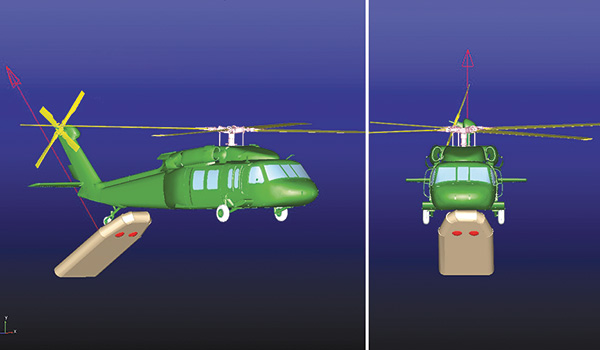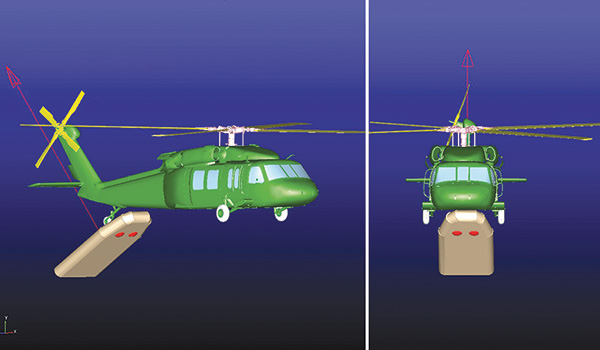
AMRDEC Tech Talk / By Mr. Tuan Pham: The Sensors Weapons Aircrew Integration (SWAI) Branch of the Army Aviation Engineering Directorate (AED) is responsible for the airworthiness aspects of armament integration into Army aircraft, including certification of external stores. External stores are mission related external devices such as guns, rockets, external fuel tanks, and test equipment.

During the airworthiness qualification process, the SWAI Branch considers armament integration safety (including safe firing envelopes, armament clearance, and engine gas ingestion), armament performance (including accuracy, effective firing envelopes, and bore sighting), and human factors (including operability, night vision compatibility, and cockpit gas ingestion).
Before AED can issue an Airworthiness Release (AWR) for aircraft carrying a new or modified store, certain requirements must be met. These requirements are defined in Aeronautical Design Standard 44 (ADS-44), Armament Airworthiness Qualification and ADS-45 Handbook, and the Data and Test Procedures for Airworthiness Release for U.S. Army Helicopter Armament Testing (Guns, Rockets, and Missiles). Serving as guidelines, ADS-44 lists all tests and analyses required for certification of new or modified stores and ADS-45-HDBK lists all data requirements and test procedures. Each new integration or modification has a special set of requirements based on past experience.
Historically, AED addressed safety issues by performing analyses such as armament clearance, jettison, or debris with pencil, paper, and a few drawings before conducting tests. A large number of actual tests were performed to cover the entire firing or jettison envelope of the aircraft. For each individual test, the motions of various parts had to be captured from multiple angles and analyzed frame-by-frame for aircraft miss-distance. These efforts were tedious and time consuming and lacked precision and accuracy. To reduce the amount of testing and time required, computer modeling and simulation allows improvements in efficiency and accuracy in miss-distance calculations by including the system dynamics in the simulation. This allows for completion of several simulation iterations in a short period of time.
MIL-STD-1289, Airborne Stores Ground Fit and Compatibility, Requirements, requires 1-inch clearance between any movable store and other stores, launcher, pylon, or aircraft surface and a minimum of 6-inches of clearance between the worst-case-position rotor blades or any parts of the aircraft and the worst-case position bullet trajectory. The clearance requirement for unguided rockets and missiles is a five-degree half angle cone measured from the outermost surface of the ordnance to the worst-case-position rotor blades or aircraft structure, as shown in Figure 1.
To meet MIL-STD-1289 requirements, an accurate 3-D representation of the aircraft and stores is necessary. A highly accurate methodology for computing the minimum distance between aircraft and stores can be accomplished using MSC Software, Automatic Dynamic Analysis of Mechanical System (ADAMS) to conduct the jettison or weapon clearance analyses. Typical simulations require:
- 3D geometries, either built from scratch with ADAMS/View or imported
- Application of forces, torques, or add splines, functions to the model
- Application of motions/maneuvers to the model
- Executing the simulation over the entire flight envelope to define the jettison envelope
One example demonstrating this analysis was the jettison of a KDUCK Inflatable Boat from a UH-60. An AWR was required within 48 hours to support soldiers on the battlefield. The KDUCK, with a gross weight between 1,000 and 1,500 pounds, is attached to the underside of the aircraft. In the event of an emergency, the boat must be released from the aircraft. Using the ADAMS software, the maximum speed for safe jettison of the boat was determined. Figure 2 shows collision between the boat and the aircraft rear tire after the boat was released at 140 knots level flight. Simulation results such as this are instrumental in determining appropriate operating limits and restrictions. With this modeling and simulation capability, what used to take weeks or months to evaluate can now be done within a few days or even a few hours.
Mr. Tuan Pham is an engineer with the Mission Equipment Division of the Aviation Engineering Directorate of the U.S. Army Aviation and Missile Research, Development, and Engineering Center at Redstone Arsenal, AL.










